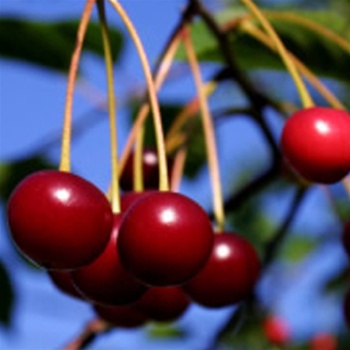Cherry trees require full sun and sharply draining fertile soil. Full sun is defined as at least 6 to 8 hours of sun each day. Sunlight is critical to fruit production and quality.
Cherry trees do not tolerate poor drainage, so it’s wise to do a percolation test before planting these fruit trees. See our percolation test blog for a how-to!
‘Montmorency’ produces large, tart, red fruit. Firm, juicy, yellow flesh. Use for pies and canning. Self-fertile.
Large, sweet, black fruit and dark red, firm, crisp, meaty flesh, ‘Black Tartarian’ is good for fresh eating or canning. Plant with ‘Bing’ or ‘Stella’ for pollination. Semi-dwarf.
The most famous sweet cherry variety, ‘Bing’ produces a very large, delicious cherry that ranges in color from a deep garnet to almost black. The skin is smooth and glossy and the flesh is firm, juicy, and sweet. Bing cherries are great for cooking as well as out-of-hand eating. Plant with ‘Black Tartarian’ or ‘Stella’ for cross-pollination.
Fragrant blooms of ‘Stella’ cherries open in early April followed in June and July by large heart-shaped, dark reddish-black cherries. And it’s self-fertile! A sweet cherry that’s also great for baking, freezing, jams and jellies.
CLICK HERE to check current availability and preorder fruit trees on our webstore.
Semi-dwarf, 15’ high x 15’ wide.
PLANTING: Amend soil by mixing up to 50% compost with existing soil.. Plant tree so soil level in container is level or slightly higher than surrounding soil. Water in to remove air pockets around roots and mulch with wood chips. The first season, water regularly to establish tree.
FERTILIZING: Adequate nutrition is essential for quality fruit production. The best thing you can do is top-dress with compost every year. A general rule of thumb for adding additional fertilizer is to apply a combined 2/3 pound of bone meal and 1/3 Texas greensand to each tree the first year, double that the second year, and triple the third and subsequent years. Fertilizer should be broadcast on the soil surface around the drip line of the tree. The “drip line” is the circular line at the outer ends of the branches.
SCAFFOLD TRAINING: Improperly trained fruit trees have very upright branch angles which can result in excessive vigor and serious limb breakage under a heavy fruit load. Larger branches can be spread out using short wooden boards with a notch cut in each end to catch the branch. Hanging weights on branches or tying it down with string wrapped loosely around the limb are other useful methods for spreading branches. All upright growth from scaffold branches should be pulled down to a horizontal position or removed.
PRUNING: A properly pruned cherry tree should have a scaffold shape, meaning that there are branches circling the tree perpendicular to the leader. There should be an area of about 2’ between each level to allow light to reach the lower leaves and fruit. Cherry trees should be pruned in late winter, encouraging the plant to grow more during the growing season. The first level of branches should begin about 2-3’ above ground level. Branches should be either weighted down or tied loosely to string to promote outward growth as opposed to vertical growth. The outward growing branches will produce more fruit and grow less vigorously. Pruning cherry trees during summer will inhibit growth, and can be done to control size in mature trees. Pruning cherry trees too early in the winter may make the tree vulnerable to bacterial infections.
